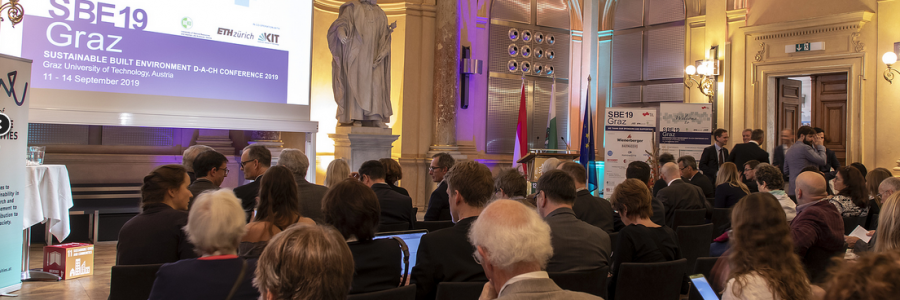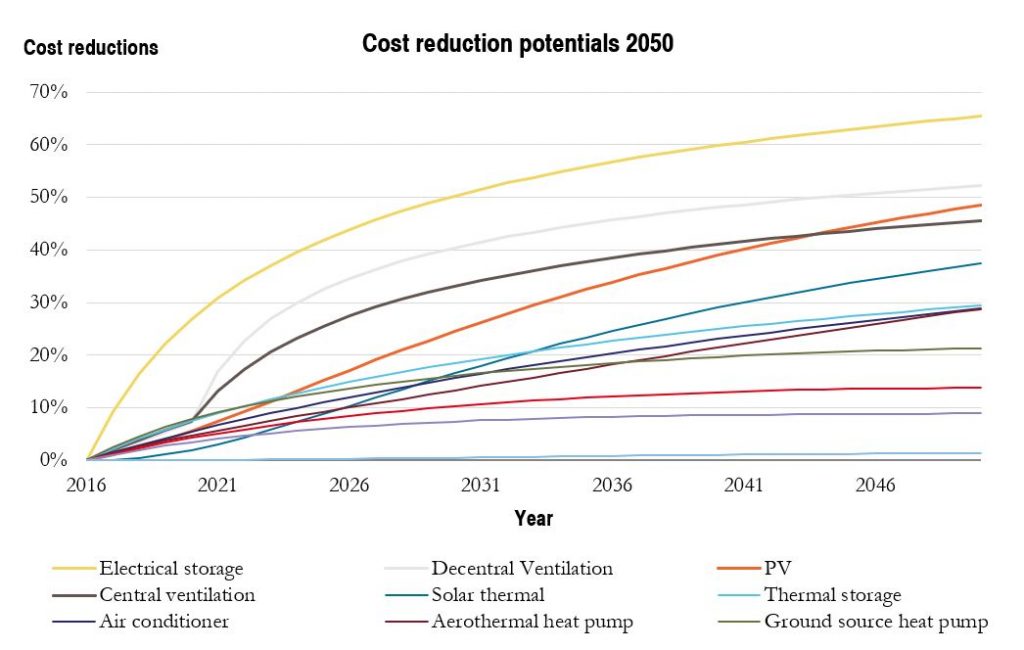
nZEB Technologies
For realising nearly zero-energy buildings (nZEBs), which are cost-efficient for all stakeholders throughout the lifecycle, the knowledge about the most important technologies and solution sets as well as possible cost developments of these technologies is essential.
The focus should always be on the minimization of energy demands (heating, cooling,ventilation, lighting) by passive approaches. The remaining energy demands must be supplied by a large extent from renewable energies onsite and as efficient as possible.
Passive approaches and active technologies to supply heat, cold, fresh air and generate energy on-site from renewable sources are the heart of each building and nZEB. An optimal combination of the available approaches and technologies can lead to high cost savings today and in the whole life cycle of a building by (i) minimize initial and replacement investment costs and (ii) minimize operation and maintenance costs. Optimal building design and the application of passive approaches play a key role here as they not only reduce the energy demand and cost during operation, they also reduce the needed installed power and thereby investment costs for active technologies.
Besides the considerations and assessments from a building owner/ operator perspective, additional considerations and factors gain importance as buildings more and more become an active and interactive part of the overall energy system. How buildings can support the integration of fluctuating renewable energies also on a broader scale is therefore also assessed and described in the following.
Many nZEB technologies do already exist today. However, their current market share is comparably low. With an increasing market share and technological developments, cost reductions are expected for most relevant technologies. The following technologies were identified as most important for nZEBs based on the various case study buildings of the CRAVEzero project and further literature review:
- Renewables: PV and solar thermal systems
- Heating: heat pumps
- Air conditioning
- Central and decentralized ventilation with heat recovery
- Thermal and electrical storage
- Insulation and other passive strategies
A highly insulated building envelope forms the basis for nZEBs.
For the calculation of possible future cost reductions, a suitable methodology based on past market developments and the current status of a specific technology (efficiency, costs) was identified and applied. With the top-down experience curve method based on learning rates for each technology and a bottom-up method to identify specific cost drivers and their respective cost reduction potentials, the cost reduction potentials of the mentioned technologies and approaches were calculated.
The central assumption of the top-down approach is that costs decrease concerning the increased cumulative production due to learning effects. More experience through the market development leads to cost reductions through technological improvements and economies of scale.
For the bottom-up method, more detailed information is needed, which is not available for all assessed technologies. Therefore, the method was only applied for PV systems, solar thermal systems and stationary lithium batteries as they are seen as technologies of major importance for nZEBs and the energy system as a whole.
For the top-down approach and to develop experience curves for the assessed technologies, current cost and cumulative volume levels, possible market development as well as learning rates based on past developments were determined. Therefore, a cost database with all data was developed, which can be accessed in the CRAVEzero-pinboard. The focus of the analyses was the EU. However, for several technologies, the availability of data was limited, and the analysis was therefore limited to Germany.
This calculated cost reduction potentials until 2050 vary from approx. 1% to 65%. Stationary batteries have the highest potential with 65%, oil and gas boilers have the lowest potential of less than 10%.
Most cost reductions due to optimizations are expected to be achieved in storage systems and renewable and energy-saving technologies such as PV and ventilation with heat recovery.
The generation and storage of electricity and heat from renewable energies provide technological combinations in buildings with considerable cost reduction potential. They can increase the self-sufficiency of buildings and reduce their carbon footprint.
Table: Ranges of cost reduction potential in 2030 and 2050
| Technology | Potential range until 2030 | Potential range until 2050 |
| PV | 20.0% – 29.0% | 41.0% – 55.5% |
| Solar thermal | 9.1% – 23.9% | 22.0% – 50.8% |
| Gas boiler: | 4.1% – 9.2% | 4.9% – 11.1% |
| Oil boiler | 0.3% – 0.7% | 0.8% – 1.9% |
| Biomass boiler | 7.2% – 13.4% | 9.6% – 17.8% |
| Aerothermal HP | 4.8% – 21.6% | 11.0% – 43.9% |
| Ground source HP | 5.9% – 25.8% | 7.9% – 33.4% |
| Thermal storage | 9.5% – 26.9% | 15.7% – 41.4% |
| Electrical storage | 34.9% – 62.7% | 47.9% – 77.7% |
| Air conditioner | 9.3% – 25.2% | 17.8% – 44.3% |
| Decentralised ventilation | 30.3% – 49.3% | 40.4% – 62.2% |
| Centralised Ventilation | 24.4% – 41.0% | 34.6% – 55.1% |

Figure: Cost reduction potentials of major nZEB technologies calculated with the top-down learning curve approach.
The derived cost reduction potentials comprise several uncertainties and many unexpected changes in policy and the economy (like e.g. the current Corona pandemic) may occur until 2050. These changes can influence specific technologies and the building sector as a whole by changing targets or promoting and subsidizing specific technologies etc.
With the bottom-up analysis several specific potential cost reduction drivers for PV, solar thermal and electrical storages were identified. For PV, the most important factors are efficiency optimizations and lower material input for the modules. For solar thermal systems, the major factors are using less material and switching to cheaper materials. Furthermore, simplification of or changes in production methods and faster assembly could lead to cost savings in the future. The latter is also highly dependent on processes in planning and construction. For electrical storages, cost reductions can be achieved through economies of scale and technological improvements like an increased energy density and the reduced and more cost-effective use of materials.
Besides the described mainly active technologies, a central part of the solution sets/ low LCC nZEBs are low-tech, passive strategies.

